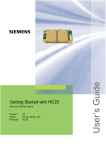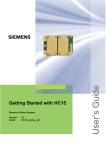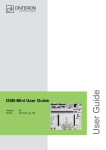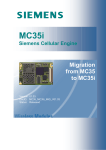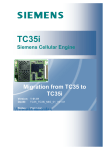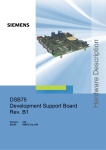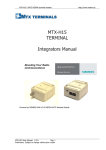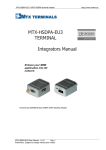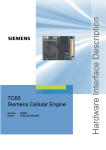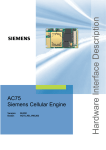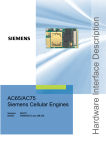Download Siemens HC15 User`s guide
Transcript
Getting Started with HC15 Siemens Cellular Engine Version: DocId: Products: 02 HC15_startup_v02 HC15 User’s Guide s s Getting Started with HC15 User’s Guide: Getting Started with HC15 Version: 02 Date: 2007-2-16 DocId: HC15_startup_v02 Status Confidential / Preliminary Supported Products: HC15 General Notes Product is deemed accepted by recipient and is provided without interface to recipient’s products. The documentation and/or product are provided for testing, evaluation, integration and information purposes. The documentation and/or product are provided on an “as is” basis only and may contain deficiencies or inadequacies. The documentation and/or product are provided without warranty of any kind, express or implied. To the maximum extent permitted by applicable law, Siemens further disclaims all warranties, including without limitation any implied warranties of merchantability, completeness, fitness for a particular purpose and non-infringement of third-party rights. The entire risk arising out of the use or performance of the product and documentation remains with recipient. This product is not intended for use in life support appliances, devices or systems where a malfunction of the product can reasonably be expected to result in personal injury. Applications incorporating the described product must be designed to be in accordance with the technical specifications provided in these guidelines. Failure to comply with any of the required procedures can result in malfunctions or serious discrepancies in results. Furthermore, all safety instructions regarding the use of mobile technical systems, including GSM products, which also apply to cellular phones must be followed. Siemens or its suppliers shall, regardless of any legal theory upon which the claim is based, not be liable for any consequential, incidental, direct, indirect, punitive or other damages whatsoever (including, without limitation, damages for loss of business profits, business interruption, loss of business information or data, or other pecuniary loss) arising out the use of or inability to use the documentation and/or product, even if Siemens has been advised of the possibility of such damages. The foregoing limitations of liability shall not apply in case of mandatory liability, e.g. under the German Product Liability Act, in case of intent, gross negligence, injury of life, body or health, or breach of a condition which goes to the root of the contract. However, claims for damages arising from a breach of a condition, which goes to the root of the contract, shall be limited to the foreseeable damage, which is intrinsic to the contract, unless caused by intent or gross negligence or based on liability for injury of life, body or health. The above provision does not imply a change on the burden of proof to the detriment of the recipient. Subject to change without notice at any time. The interpretation of this general note shall be governed and construed according to German law without reference to any other substantive law. Copyright Transmittal, reproduction, dissemination and/or editing of this document as well as utilization of its contents and communication thereof to others without express authorization are prohibited. Offenders will be held liable for payment of damages. All rights created by patent grant or registration of a utility model or design patent are reserved. Copyright © Siemens AG 2007 Trademark notice MS Windows® is a registered trademark of Microsoft Corporation. HC15_startup_v02 Confidential / Released Page 2 of 36 2007-2-16 s Getting Started with HC15 Contents 36 Contents 1 Introduction............................................................................................................................. 4 1.1 Related Documents ....................................................................................................... 4 1.2 Abbreviations................................................................................................................. 5 2 Installation and Configuration............................................................................................... 6 2.1 Technical Requirements for Running HC15 on DSB75................................................. 6 2.2 Installing the Hardware.................................................................................................. 7 2.3 Installing Connection Manager and Preparing Driver Installation.................................. 9 2.4 Installing USB and Ethernet Drivers ............................................................................ 11 2.5 Special Installation Notes ............................................................................................ 14 2.6 Installed Devices and Tools......................................................................................... 15 2.7 Uninstalling Drivers and Connection Manager ............................................................ 16 2.8 Uninstalling Drivers and Tools from Earlier HC15 Releases ....................................... 17 2.8.1 Uninstalling Earlier Drivers ............................................................................. 17 2.8.2 Uninstalling Earlier Connection Manager ....................................................... 17 3 Using the HC15 Module........................................................................................................ 18 3.1 AT Command Interpreter............................................................................................. 18 3.2 Switching on the HC15 ................................................................................................ 19 3.3 Switching off the HC15 ................................................................................................ 19 3.4 Registering to the Network .......................................................................................... 19 3.5 Selecting UMTS or GSM ............................................................................................. 20 3.6 Attaching to the HSDPA or GPRS Network................................................................. 21 3.7 Defining the PDP Context............................................................................................ 21 3.8 Making a Voice Call (MO)............................................................................................ 22 3.9 Answering a Voice Call (MT) ....................................................................................... 22 3.10 HSDPA or GPRS Data Transfer.................................................................................. 23 3.10.1 HSDPA or GPRS Data Transfer via Siemens Wireless Ethernet Adapter ..... 23 3.10.2 HSDPA or GPRS Data Transfer via Dial-Up Network .................................... 24 3.10.2.1 Local Echo Settings ........................................................................ 25 4 Appendix I ............................................................................................................................. 26 4.1 Adding and Configuring a New Dial-Up Connection.................................................... 26 4.1.1 Creating a New Dial-up Network Connection ................................................. 26 4.1.2 Configuring a Dial-up Network Connection .................................................... 29 5 Appendix II ............................................................................................................................ 32 5.1 Configuring DSB75 Support Board and Adapter Board .............................................. 32 6 Index ...................................................................................................................................... 36 HC15_startup_v02 Confidential / Released Page 3 of 36 2007-2-16 s Getting Started with HC15 1 Introduction 1 Introduction HC15 is the first Siemens wireless module to offer UMTS and GSM capability on the same device. The benefit is that the HC15 includes HSDPA capability in a UMTS network and also all common mobile connectivity features like voice, short messages, GPRS and EGPRS. The HC15 modules need to connect to an adequate host device, such as the Evaluation Board DSB75. Designed to help application manufacturers and system integrators to test and develop their HC15 host application, the DSB75 provides all interfaces and peripherals needed to run the HC15. The purpose of this document is to guide you through the process of connecting the hardware, installing the software on a Windows XP system, and, last but not least, making the first data transmission via UMTS and HSDPA. 1.1 Related Documents Documents supplied with HC15 [1] HC15 Hardware Interface Description [2] HC15 AT Command Set [3] HC15 Release Notes Other related documents [4] DSB75 Development Support Board Hardware Description Designed for a wide range of Siemens wireless modules this document is ready for download on the Siemens Website: http://www.siemens.com/wm HC15_startup_v02 Confidential / Released Page 4 of 36 2007-2-16 s Getting Started with HC15 1.2 Abbreviations 1.2 Abbreviations Abbreviation Description APN Access Point Name CHAP Challenge Handshake Authentication Protocol GPRS General Packet Radio Service HSDPA High-Speed Downlink Packet Access IP Internet Protocol ME Mobile Equipment MO Mobile Originated MT Mobile Terminated PAP Password Authentication Protocol PDP context Packet Data Protocol context TA Terminal Adapter TE Terminal Equipment UICC Universal Integrated Circuit Card UMTS Universal Mobile Telecommunication System URC Unsolicited Result Code HC15_startup_v02 Confidential / Released Page 5 of 36 2007-2-16 s Getting Started with HC15 2 Installation and Configuration 2 Installation and Configuration 2.1 Technical Requirements for Running HC15 on DSB75 • Windows XP computer, minimum USB 1.1 connector • HC15 module • HC15 driver package Modules shipped from factory have the driver package available in the mass storage and are prepared for easy installation. Please follow the installation guidelines provided below: First connect the HC15 module to the DSB75 and start the computer (see Section 2.2). Then install the Siemens Connection Manager to prepare the driver installation (see Section 2.3). Finally install the drivers (see Section 2.4). • Local Administrator Privileges on the particular Windows XP computer are required to install the Siemens Connection Manager. • If drivers from earlier HC15 preview releases are still installed be sure to uninstall them first. See Section 2.8 • USB cable • DSB75 Evaluation Board providing the application interface between the HC15 USB port and the computer's USB port. • Adapter for mounting the HC15 module onto the DSB75 • 9 to 15 Volts power supply applied at the DSB75 for powering up the DSB75 and the connected HC15 module • 1 mini antenna cable (50 Ohms) from the Hirose U.FL connector on the HC15 module to the Hirose U.FL on the DSB75; 1 external RF antenna connecting to the SMA connector of the DSB75 (product name: SMARTEQ MiniMag), both delivered with DSB75 • Metal plate for grounding the external RF antenna, min. 20 cm x 20 cm • Optional: Handset, eg. Handset for Siemens products from Votronic delivered with DSB75 • Terminal program to control the USB port under Windows, for example Windows Hyperterminal • UICC card • Service provider settings for access to the GPRS and HSDPA services, as a rule the following: - APN (network operator specific Name of Access Point that connects the GSM network to the Internet) - Primary and secondary DNS - IP address (DHCP or static) - QoS settings - User name and password • HC15 offers two ways to access the GPRS or HSDPA networks: either the Siemens Wireless Ethernet Adapter controlled by the Siemens Connection Manager or a dial-up network connection set up via the Siemens HSDPA USB Modem. For details see Section 3.10. • Make sure to operate the HC15 always with the UICC card inserted in the DSB75 card reader and a valid SIM PIN entered. This is because most AT commands require SIM PIN authentication. HC15_startup_v02 Confidential / Released Page 6 of 36 2007-2-16 s Getting Started with HC15 2.2 Installing the Hardware 2.2 Installing the Hardware To properly connect the HC15 module and all accessories to the DSB75 Support Board follow these steps: • Check that all switches of the DSB75 Support Board are set as described in Chapter 5. See also Figure 4 which shows an exploded view of all parts. • Connect the one end of the mini antenna cable to the Hirose U.FL connector located on the module's top side. • Mount the HC15 module upside down onto the 50-pin board-to-board connector of the adapter board. Use the supplied M2 screws and nuts to screw the module to the adapter board. • Attach the adapter board to the 80-pin header located on the DSB75. Take gentle care that all pins are aligned correctly, then press down evenly on the adapter board until it is firmly seated. Use the supplied M3 screw and bolt to secure the adapter board to the DSB75 Support Board. • Connect the other end of the mini antenna cable to the the Hirose U.FL connector of the DSB75. • Screw the external antenna (MiniMag) into the SMA connector on the DSB75. To improve the antenna performance use the metal plate for grounding. The external antenna should be positioned in the center of the metal plate. • Connect the Western plug of the handset to the Western jack on the DSB75. • Connect the power cables to the red (BATT+) and black (Ground) connectors of the DSB75. • Plug the USB cable to the computer's USB port and to the USB port of the DSB75. Press the IGT key of the DSB75 to switch on the HC15 module. Start your Windows XP computer. • See Section 2.3 to continue. USB connector Power supply DSB75 Evaluation Board Mini antenna cable Adapter board 50-pin board-to-board connector Hirose U.FL connector SMA connector Western jack UICC/SIM reader for handset IGT key (left) and EMERG_OFF key (right) Figure 1: DSB75 with mounted adapter board and mini antenna cable HC15_startup_v02 Confidential / Released Page 7 of 36 2007-2-16 s Getting Started with HC15 2.2 Installing the Hardware Figure 2: DSB75 with HC15 module and accessories connected HC15_startup_v02 Confidential / Released Page 8 of 36 2007-2-16 Getting Started with HC15 2.3 Installing Connection Manager and Preparing Driver Installation 2.3 s Installing Connection Manager and Preparing Driver Installation After powerup, you will see the “New Hardware Found Wizard“ coming up three times. Click Cancel in each dialog. At the same time the module appears as a mass storage device in your Windows XP system, showing up as a Removable Disk assigned to the next free drive in the Windows Explorer. The supplied HC15 driver software is available on this drive. An additional Windows system tray icon also indicates the mass storage device. The wizard’s error message that pops up in the Windows taskbar shall be ignored. The installation will proceed automatically. Note: If the installation fails to start automatically after you have canceled the three “New Hardware Found Wizards“ simply navigate to the mass storage drive (= Removable Disk in the Windows Explorer) and double-click the provided “autorun.exe“ file. Please wait a brief moment, then press Install to start the installation of the Connection Manager. HC15_startup_v02 Confidential / Released Page 9 of 36 2007-2-16 Getting Started with HC15 2.3 Installing Connection Manager and Preparing Driver Installation s The progress of the installation will be indicated as illustrated below. It is possible that there are up to 3 warning messages saying that the drivers are not digitally signed. Please ignore the messages and press Continue anyway. Now the installation of the Connection Manager is completed, and the driver software is preinstalled. The last installation dialog closes automatically. See Section 2.4 to continue. HC15_startup_v02 Confidential / Released Page 10 of 36 2007-2-16 s Getting Started with HC15 2.4 Installing USB and Ethernet Drivers 2.4 Installing USB and Ethernet Drivers HC15 is installed as a composite device that comprises three virtual devices, one by one added to your Windows XP system: • Siemens USB Com Port driver • Siemens Wireless Ethernet Adapter driver • Siemens HSDPA USB Modem driver During the installation, the HC15 USB interface will be assigned two virtual COM ports, one for the virtual modem port and one for the virtual application port. Windows will automatically allocate the next available COM port to each virtual interface. Once the Connection Manager installation has completed Windows detects the HC15 as a new USB composite device. The Found New Hardware Wizard will start. Click Next to proceed with the installation of the "Siemens USB Com Port". The progress of the driver installation is indicated. It is possible that there are up to 3 warning messages saying that the drivers are not digitally signed. Please ignore the messages and press Continue anyway. Click Finish to complete the installation of the "Siemens USB Com Port". HC15_startup_v02 Confidential / Released Page 11 of 36 2007-2-16 s Getting Started with HC15 2.4 Installing USB and Ethernet Drivers Now the installation of the "Siemens Wireless Ethernet Adapter" will start. Click Next. The progress of the driver installation is indicated. It is possible that there are up to 3 warning messages saying that the drivers are not digitally signed. Please ignore the messages and press Continue anyway. Press Finish to complete the "Siemens Wireless Ethernet Adapter" installation. HC15_startup_v02 Confidential / Released Page 12 of 36 2007-2-16 s Getting Started with HC15 2.4 Installing USB and Ethernet Drivers Now the installation of the "Siemens HSDPA USB Modem" will start. Click Next. The progress of the driver installation is indicated. It is possible that there are up to 3 warning messages saying that the drivers are not digitally signed. Please ignore the messages and press Continue anyway. Press Finish to complete the "Siemens HSPDA USB Modem" installation. At this point the installation of all three virtual devices is completed. Windows XP notifies you that the hardware is ready to use. HC15_startup_v02 Confidential / Released Page 13 of 36 2007-2-16 s Getting Started with HC15 2.5 Special Installation Notes 2.5 Special Installation Notes If the installation does not work as expected, additional steps may be required, usually depending on the configuration of the Windows XP computer. HC15 does not show up as removable disk • If the HC15 is not visible as removable disk (mass storage device) when connected and switched on the first time, it is possible that the computer is configured to search the Internet for Windows updates. As a result, Windows is waiting for additional user action. • To avoid this scenario, it is recommended to switch off this option before trying to install the HC15. Connection Manager installed, but driver installation does not start • If the Connection Manager installation completes successfully as explained in Section 2.3, but the driver installation does not start as shown in Section 2.4, it is possible that the HC15 has failed to change from mass storage device to composite device functionality. • In this case, please stop the mass storage function manually. To do so, right-click the “Removable Disk“ drive and select Eject. The installation should proceed according to Section 2.4. If the HC15 still shows up as removable device, point to the associated Windows system tray icon, and select Stop from the resulting Safely Remove Hardware box. Then unplug and replug the USB cable. HC15_startup_v02 Confidential / Released Page 14 of 36 2007-2-16 s Getting Started with HC15 2.6 Installed Devices and Tools 2.6 Installed Devices and Tools After successful installation, the HC15 module is set up as composite device comprising the virtual devices listed below. Under Windows XP, you can use the Device Manager to check that all components are properly installed and configured. Siemens HSDPA USB Modem • AT command and data interface, also referred to as "Modem" interface if queried using the AT^SQPORT command. • Intended particularly for HSDPA and GPRS data connections. • The virtual COM port Windows has assigned to this interface is listed in the Device Manager under Modems and under Control Panel | Phone and Modem Options. • The port number can be gathered from the property pages. This COM port can be used to set up dial-up network connections. The bit rate set by default on the modem property page is not relevant for USB and can be left unchanged. On the Advanced tab you can put the command string used to define the PDP context for your GPRS / HSDPA provider. See also Section 3.7. HC15_startup_v02 Confidential / Released Page 15 of 36 2007-2-16 Getting Started with HC15 2.7 Uninstalling Drivers and Connection Manager s Siemens USB Com Port • AT command interface, also referred to as "Application" interface if queried using the AT^SQPORT command. • Mainly intended for controlling the HC15 module, for receiving URCs, can be used also for sending, receiving, writing and reading short messages. Not intended as data interface for HSDPA and GPRS. • The virtual COM port Windows has assigned to this port is listed in the Device Manager under Ports (COM&LPT). Siemens Wireless Ethernet Adapter • Wireless network adapter intended for HSDPA and GPRS data connections. • Listed in the Device Manager under Network adapters. • Software controlled by the Siemens Connection Manager. To open the program in Windows XP, click Start, point to Programs, select Siemens, select HSDPA USB Modem and click Connection Manager. See Section 3.10 and Section 3.10.1 for details of how to set up a connection. 2.7 Uninstalling Drivers and Connection Manager 1. Ensure that the module is connected to the computer’s USB port and switched on. 2. Select Control Panel | Add or Remove Programs and Connection Manager. Press Remove to select the uninstaller of the Connection Manager and the HC15 drivers. 3. Press Yes to start the uninstaller. The Connection Manager and all HC15 drivers will be removed. HC15_startup_v02 Confidential / Released Page 16 of 36 2007-2-16 Getting Started with HC15 2.8 Uninstalling Drivers and Tools from Earlier HC15 Releases 2.8 s Uninstalling Drivers and Tools from Earlier HC15 Releases The following procedures apply only to drivers of earlier HC15 releases supplied as preview samples for testing only. 2.8.1 Uninstalling Earlier Drivers 1. Under Windows XP, open the Device Manager and select the drivers as described in Section 2.6. Keep in mind that the drivers are listed in the Device Manager only when the module is switched on. Right-click the driver and, from the resulting menu, select Uninstall. 2. 3. Under ..\WINDOWS\system32\drivers remove the two files “hcusbser.sys“ and “hcusbnet.sys“. Under ..\WINDOWS\INF check for old “oem*.inf“ and “oem*.pnf“ files and remove all files related to earlier customer samples. To do so, open the currently installed “oem*.inf“ file(s) and compare the content with the “hcser.inf“ and “hcnet.inf“ supplied with the customer samples. All “oem*.inf“ and associated “oem*.pnf“ files based on information from old “hcser.inf“ and “hcnet.inf“ files must be removed. An easy way to compare the content of these files is checking the information given in the [Siemens] section, such as the two examples shown below: Examples: [SIEMENS] %hcwwan.DeviceDesc_hc1% = hcwwan.ndi, USB\VID_0681&PID_003E&MI_01 [SIEMENS] %hcwwan.DeviceDesc_hc1% = hcwwan.ndi, USB\VID_05C6&PID_7001&MI_01 2.8.2 Uninstalling Earlier Connection Manager Old versions of the Siemens Connection Manager were installed in Windows XP under Program Files | Siemens | ConnectionManager. To uninstall the program simply remove the "conman.exe" file. Any shortcuts and icons must be deleted manually. HC15_startup_v02 Confidential / Released Page 17 of 36 2007-2-16 s Getting Started with HC15 3 Using the HC15 Module 3 Using the HC15 Module The following examples show the basic steps required to register to the network, to select UMTS mode or GSM mode and to attach to HSDPA or GPRS. The examples are based on a UICC card provisioned by the German network operator T-Mobile. The used UICC card is capable of UMTS and GSM and enables the subscriber to switch back and forth between both networks. 3.1 AT Command Interpreter AT commands can be entered on two interfaces of the HC15 module: • Siemens HSDPA USB Com Port • Siemens HSDPA USB Modem Yet, we recommend that the Siemens HSDPA USB Com Port be used for controlling the HC15 module, eg. for entering AT commands and receiving URCs, while the Siemens HSDPA USB Modem is mainly intended for use as a modem. For greater detail refer to [2], especially sections "AT Command Interpreter" and "Unsolicited Result Code Presentation". As described in Section 2.6, each interface is assigned a virtual COM port of its own, which enables accessing the interface from the host application or, accordingly, the . To easily identify both interfaces you can use the AT^SQPORT command: AT^SQPORT Application On the AT command interface, the Siemens HSDPA USB Com Port is referred to as "Application". OK AT^SQPORT Modem On the AT command interface, the Siemens HSDPA USB Modem is referred to as "Modem". OK If you need to operate the HC15 from both interfaces at a time, bear in mind that both are handled by the same AT command interpreter. As a result, AT commands entered on both interfaces are not executed in parallel but sequentially, one after the other. So, an AT command issued on one interface will be buffered on this interface to be executed after the other interface has completed processing earlier AT command(s). The buffered command string is not echoed, but will be indicated when executed. HC15_startup_v02 Confidential / Released Page 18 of 36 2007-2-16 s Getting Started with HC15 3.2 Switching on the HC15 3.2 Switching on the HC15 The HC15 can be started by pressing the IGT key of the DSB75. Please wait approximately 2 seconds before using the module, for example before entering AT commands. 3.3 Switching off the HC15 To shut down the HC15 module, enter the AT^SMSO command. This enables the ME to save all data and perform an orderly shutdown. AT^SMSO OK The ME switches off. The HC15 module can also be switched off by using the IGT line as described in [2], Section AT^SCFG and in [1], Section "Configuring the IGT Line for Use as ON/OFF Switch") 3.4 Registering to the Network Make sure to operate the HC15 always with the UICC card inserted in the DSB75 card reader and a valid SIM PIN entered. This is because most AT commands require SIM PIN authentication. Write command: AT+CPIN=<pin>[, <new pin>] AT+CPIN? +CPIN: SIM PIN OK AT+CPIN=“1234“ OK AT+CPIN? +CPIN: READY OK HC15_startup_v02 Confidential / Released Entering the SIM PIN. Page 19 of 36 2007-2-16 s Getting Started with HC15 3.5 Selecting UMTS or GSM 3.5 Selecting UMTS or GSM The GSM 07.07 operator selection command AT+COPS has been enhanced to enable the subscriber to select whether to use UMTS or GSM. You can quickly switch back and forth between both network types while the ME remains registered. Write command: AT+COPS=<mode>[, <format>[, <oper>[, <act>]]] The parameter <act> (access technology) can take the values listed below. The parameter is stored non-volatile. 0 GSM network 2 UMTS network Note: By factory default, an automatic network selection mode is set which enables the ME to select either UMTS or GSM, depending on the network coverage. This automatic mode remains enabled until you explicitly set either UMTS or GSM using the <act> parameter of AT+COPS. Setting the <act> parameter forces the ME to select either UMTS only or accordingly, GSM only. If the specified network is not available, the network registration will be disabled. Setting <mode> to 0 without choosing a specific <act> enables the automatic selection mode once again. AT+COPS? +COPS: 0,0,"T-Mobile D",2 Querying the current network mode. The ME is registered to the German operator TMobile and uses UMTS. OK AT+COPS=0,,,0 #(or AT+COPS=,,,0) OK AT+COPS? +COPS: 0,0,"T-Mobile D",0 Selecting the GSM network. Query the current network type. The response confirms that the ME has changed to the GSM network. OK AT+COPS=0,,,2 #(or AT+COPS=,,,2) OK AT+COPS? +COPS: 0,0,"T-Mobile D",2 Selecting the UMTS network. OK AT+CPIN? +CPIN: READY There is no need to enter the SIM PIN again. OK AT+COPS=0 OK Setting automatic network selection mode. Furthermore, the command AT+COPS serves to query or specify several modes of selecting the GSM network operator. These functions are not discussed in this document. HC15_startup_v02 Confidential / Released Page 20 of 36 2007-2-16 s Getting Started with HC15 3.6 Attaching to the HSDPA or GPRS Network 3.6 Attaching to the HSDPA or GPRS Network After PIN authentication, the HC15 module automatically tries to attach to the HSDPA or, accordingly, GPRS network. AT+CGATT? +CGATT: 1 Querying the current service state. The ME is attached, depending on the selected network type (see AT+COPS), it is either attached to the HSDPA or GPRS service. OK 3.7 Defining the PDP Context Use the AT+CGDCONT command to configure the correct provider settings. The PDP context is stored non-volatile. Write command: AT+CGDCONT=<cid>[, <PDP_type>[, <APN>[, <PDP_addr>]]] AT+CGDCONT=1,"IP","internet.t-mobile" OK Specifying the PDP context (example shows the APN of the German network provider T-Mobile). Checking the current PDP context definition. AT+CGDCONT? +CGDCONT: 1,"IP","internet.t-mobile","",0,0 OK The focus of this document is only on the parameters <cid>, <PDP_type> and <APN>. The string parameters must be enclosed in quotation marks. Under Windows XP, the PDP context can, optionally, be entered on the Modem property page as described in Section 2.6. HC15_startup_v02 Confidential / Released Page 21 of 36 2007-2-16 s Getting Started with HC15 3.8 Making a Voice Call (MO) 3.8 Making a Voice Call (MO) The commonly used GSM 07.07 dialing command ATD is fully applicable both in the UMTS and the GSM network. To make a mobile originated voice call enter ATD, type the destination number and add a semicolon. The result code OK will be returned immediately after dialing, prior to call setup. To end the call, use the AT+CHUP command (ATH is for data calls only). ATD030111111111; OK at+clcc +CLCC: 1,0,0,0,0,"030111111111",129,"Tom" The HC15 subscriber makes a voice call. AT+CHUP OK The HC15 subscriber terminates the call. at+clcc OK Checking the call status (no call). 3.9 Checking the call status (MO call is active). Answering a Voice Call (MT) A mobile terminated voice call is indicated by the RING URC. To answer the call, enter ATA. To terminate the call use AT+CHUP. HC15_startup_v02 Confidential / Released Page 22 of 36 2007-2-16 s Getting Started with HC15 3.10 HSDPA or GPRS Data Transfer 3.10 HSDPA or GPRS Data Transfer HC15 offers two alternatives to access the GPRS or HSDPA networks: • The Siemens Connection Manager provided for the Siemens Wireless Ethernet Adapter. See Section 3.10.1. • A dial-up network connection via the installed Siemens HSDPA USB Modem as described in Section 3.10.2. In either case the ME must be registered to the network. So, before trying to connect to the data services ensure that SIM PIN authentication was done from the host application. To take advantage of HSDPA make sure that the <act> parameter of AT+COPS equals "2". For GPRS the parameter shall be "0". It is recommended to configure these settings on the Siemens HSDPA USB Com Port. 3.10.1 HSDPA or GPRS Data Transfer via Siemens Wireless Ethernet Adapter The easiest way is using the Siemens Connection Manager installed along with the HC15 driver package. • To open the tool in Windows XP, click Start, point to Programs, select Siemens, select HSDPA USB Modem and click Connection Manager. • Use the Select Device listbox to choose the Siemens Wireless Ethernet Adapter. When opened the first time or after disabling the adapter, the listbox may be empty. • Check the APN Name box and enter the APN (Access Point Name) of your service provider. • If necessary, check the Authentication Preference box and select the type of authentication protocol. Otherwise, PAP and CHAP apply by default. Username and password are also provider dependent. • Press the Connect button to set up a connection. Then simply open your Internet browser. The box on the rightmost bottom represents the signal strength. • To close the connection press the Disconnect button (available when connected). The Auto Connect check box on the leftmost bottom can be activated if you want the Siemens Wireless Ethernet Adapter to automatically connect to the network each time you restart the HC15. This option can be used particularly with a flat rate subscription. In this case, take care that the SIM PIN authentication is also done automatically. HC15_startup_v02 Confidential / Released Page 23 of 36 2007-2-16 s Getting Started with HC15 3.10 HSDPA or GPRS Data Transfer 3.10.2 HSDPA or GPRS Data Transfer via Dial-Up Network Before dialing, make sure that the virtual COM port is not used by any application (eg. by a terminal program or by the host application). Also, ensure that you have the PDP context for your service provider defined by using the AT+CGDCONT command. The command string can be entered either on the Modem property page on the Windows Control Panel or in the host application (see Section 2.6 and Section 3.7). From the Control Panel, choose Network Connections and select the dial-up network connection created for HC15. (Instructions on how to create a new dial-up network connection can be found in Chapter 4.) The correct dial string *99***1# should already be given, if entered in the Phone number box when the dial-up network connection was added. Otherwise, you can type the number here before dialing. User name and password may or may not be required, depending on the network operator. The connection is properly established when the following messages are reported: Note that the message showing “Speed 115.2 kbps“ can be ignored. It is only a Windows standard message for modems which is neither relevant for USB nor does it reflect the true data rate used on the air interface. To verify the data rates for up- and/or downlink, you can use, for example, the file download status dialog of your Internet browser. HC15_startup_v02 Confidential / Released Page 24 of 36 2007-2-16 s Getting Started with HC15 3.10 HSDPA or GPRS Data Transfer Terminating the dial-up network connection To stop a HSDPA or GPRS data connection disconnect the dial-up network connection. This can be done in two ways: 1. Double-click the dial-up network connection icon in the system tray. In the resulting connection status dialog press the Disconnect button. 2. The other way is available on the Network Connections page of the Control Panel: Right-click the active connection to open a context menu where to choose Disconnect. 3.10.2.1 Local Echo Settings Due to the initialization strings typically set by modems, a dial-up network connection may automatically change the local echo settings: Opening a dial-up network connection deactivates (ATE0) and activates (ATE1) the local echo. Releasing the dial-up network connection deactivates the echo once again (ATE0). As modem and application interface are controlled from the same AT command interpreter the change takes effect on both interfaces. Therefore, after closing a dial-up network connection you are advised to wait a few seconds before entering an AT command on the Application interface. Otherwise, it is possible that the echo deactivation command ATE0 is still being executed on the modem interface while another AT command is already entered on the application interface. As a result, the AT command response expected on the application interface may appear incomplete. Likewise, if you enter an AT command on the application interface in parallel to a dial-up network connection running on the modem interface at the time when the echo is deactivated take into account that the expected response may be indicated either partially or not at all. Each time after closing a dial-up network connection you are advised to send the ATE1 command to enable the local echo again. HC15_startup_v02 Confidential / Released Page 25 of 36 2007-2-16 s Getting Started with HC15 4 Appendix I 4 Appendix I 4.1 Adding and Configuring a New Dial-Up Connection This section describes how to create and configure a new dial-up network connection when using the installed Siemens HSDPA USB Modem to access the GPRS or HSDPA network: 4.1.1 Creating a New Dial-up Network Connection There are several ways to start creating a new dial-up network connection. For example, open the Control Panel, double-click Network Connections, select New connection. Another way is to select Settings from the Start menu, click Network Connections, then New Connection Wizard. In any case, the Network Connection Wizard opens. Click Next to continue. Put a check mark on Connect to the Internet and click Next. HC15_startup_v02 Confidential / Released Page 26 of 36 2007-2-16 Getting Started with HC15 4.1 Adding and Configuring a New Dial-Up Connection s Select the option Set up my connection manually and click Next. Select Connect using a dial-up modem and click Next. Select the modem that you want to use for the dial-up network connection. Click Next to continue. Type an appropriate Connection name and click Next. HC15_startup_v02 Confidential / Released Page 27 of 36 2007-2-16 Getting Started with HC15 4.1 Adding and Configuring a New Dial-Up Connection s In the Phone number box, put the dial string *99***1# commonly used to access the GPRS network. Note: The number "1" added before the hash determines that the first PDP context shall be used. The number must be identical to the <cid> value set with AT+CGDCONT (see Section 3.7). Depending on the network, you may be required to put a User name and a Password for the dial-up network connection. If not required, you may leave all boxes empty. Click Next and, in the resulting dialog, click Finish. This will cause the Connect… dialog to appear (screen is shown in Section 4.1.2). Yet, at this moment, it is recommended that you press Cancel in order to check, and if necessary, to configure the dial-up network connection as described in Section 4.1.2. HC15_startup_v02 Confidential / Released Page 28 of 36 2007-2-16 Getting Started with HC15 4.1 Adding and Configuring a New Dial-Up Connection 4.1.2 s Configuring a Dial-up Network Connection Every newly created dial-up network connection should be configured before using it to establish a PPP connection. Open the Control Panel, double-click Network Connections, select the dial-up network connection you want to configure. In the resulting Connect… dialog, press the Properties button. On the General tab, select the modem you want to configure. The correct dial string *99***1# should already be given, if entered before in the Phone number box when the dial-up network connection was created (see Section 4.1.1). HC15_startup_v02 Confidential / Released Page 29 of 36 2007-2-16 Getting Started with HC15 4.1 Adding and Configuring a New Dial-Up Connection s Select the Security tab to verify or edit authentication options for PPP connections. By default, MS Windows XP enables the option Typical with unsecured passwords for the commonly used but unsafe PAP authentication method. As this is the minimum level of security supported in all networks the setting usually enables the subscriber to make a connection, though at the expense of security. Many network operators apply more secure authentication methods for PPP connections, such as CHAP. For access to these networks, activate the Advanced (custom setting) option and press the Settings button. On the resulting Advanced Security Settings property page, enable / disable the authentication protocols according to the information provisioned by your service provider. Note: If an attempt to connect to a HSDPA or GPRS network fails, check that the authentication protocols are properly set. HC15_startup_v02 Confidential / Released Page 30 of 36 2007-2-16 Getting Started with HC15 4.1 Adding and Configuring a New Dial-Up Connection s On the Networking tab, the default settings are acceptable in most cases: The drop-down menu shows PPP: Windows 95/98/NT/2000, Internet for the type of dialup server as default. In the PPP settings box, verify that Enable LCP extensions and Enable software compression are selected and click OK. Select the Internet Protocol (TCP/IP) on the Networking tab and press the Properties button to go to the General page. In most cases, it is sufficient to accept the default settings: Obtain an IP address automatically and Obtain DNS server address automatically. Otherwise, you have to select the options Use the following IP address / Use the following DNS addresses and specify the IP addresses provisioned by your network operator. The Advanced button opens a further property page where you can set your preferences when working in a local network and a dial-up network at the same time. HC15_startup_v02 Confidential / Released Page 31 of 36 2007-2-16 s Getting Started with HC15 5 Appendix II 5 Appendix II 5.1 Configuring DSB75 Support Board and Adapter Board This section refers to the DSB75 Support Board and the adapter board needed to mount a HC15 module onto the DSB75 Support Board. The focus is on the configuration of several switches you may be required to change for use with HC15. A detailed description of the DSB75 Support Board is given in [4]. Please check that all slide switches (S100 - S103) on your HC15-DSB75 adapter board are set as shown in Figure 3. 80-pin header X108: Not poplulated X106, X107: Not populated X104: 50-pin board-toboard connector for HC15 Figure 3: HC15_startup_v02 Confidential / Released HC15-DSB75 adapter board - switch settings Page 32 of 36 2007-2-16 s Getting Started with HC15 5.1 Configuring DSB75 Support Board and Adapter Board Figure 4: Mounting HC15 to DSB75 (exploded view ) HC15_startup_v02 Confidential / Released Page 33 of 36 2007-2-16 s Getting Started with HC15 S 112 S1 11 S7 11 S7 10 V430 = yellow LED (HC15 on) V431 = green LED (DSB75 on) X505 = Hirose U.FL X506 = SMA connector S110 X12 0 X110 = USB connector S7 15 S7 14 X410 X400 = power supply connector (red) for 9V - 15V X401 =GND (black) X710 5.1 Configuring DSB75 Support Board and Adapter Board X201, X202, X205: Do not use S457 S456 S455 S452 S453 S454 S451 S450 S462 S461 S460 S463 S464 S465 S466 S467 S468 S469 S459 S458 S 551 S 552 X100: Do not use S 504 X5 60 S5 01 X5 61 X203 S 503 S307 S73 0 X503 = SIM card holder S7 31 S717 S716 X500 S20 1 X101, X102 = 80-pin header for adapter board S713 S712 S200 S554 S30 0 S30 2 S30 4 S306 S 502 S30 1 S30 3 S3 05 S5 00 X502 = Audio western jack X420 = EMERG_OFF X421 = IGT Figure 5: DSB75 Support Board - switches, connectors, LEDs (overview) HC15_startup_v02 Confidential / Released Page 34 of 36 2007-2-16 s Getting Started with HC15 5.1 Configuring DSB75 Support Board and Adapter Board 2-F9 MICP 50 2-G5,2-G7 CCCLK 2 2-F5,2-F7 48 3 2-G5,2-G7 47 4 46 5 45 6 CCIO VAL CCIO_D 10 CHARGEGATE VCHARGE DSR0 2-C10 17 2-C9 18 RTS0 USB_DN TXD0 USC5 RTS1 I2CCLK SD_D0 22 2-C9 RXD0 DCD0 BATTEMP IGT AGND USC2 2-G8 MICN1 USC3 2-F8 MICP1 USC4 2-F8 MICP2 CCGND_D 35 2-C7 PWR_IND 36 40 31 20 30 21 29 22 $V TP_RES 28 23 27 24 21 26 EPN C103 1N C105 1N C104 1N C106 1N 2-E8 SDCC_D3 2-E8 SDCC_D1 AGND 2-E8 SDCC_CMD 2-D2 IGT 2-D2 EMERG_RST 2-E9 APP_CTRL0 2-C2 S100 TXD0 1 $V,$P 3 2 2-D2 RXD0 2-E9 S101 APP_CTRL2 1 $V,$P 2-E9 APP_CTRL3 3 2 2-D2 CTS0 2-E9 APP_CTRL1 2-C2 RTS0 2-D4 GPIO7 2-D4 GPIO8 VEXT 25 $V,$P SM D BATT+ X104 GN D 50-POL R100 VSIM_D VSIM 0R 2-B4 2-B4 R102 2-E2 2-B7,2-F5 CCIO_D CCIO 0R 36 2-C4 MICP1 2-E2 MICP2 2-E2 MICN1 R103 2-B4 2-B7,2-G5 CCCLK CCCLK_D 38 MICN2 C107 100N 3 C108 100N 2 C109 100N 3 2 S102 1 2-B11 MICP S103 1 2-B11 MICN 0R 39 GN D 2-B7,2-F5 CCIN 0R 35 40 R101 CCIN_D 37 $O,$V X100 19 GP_CLK 20 34 GN D AD1_IN 39 32 VDDLP 33 DAC_OUT 38 18 32 AD2_IN 37 33 GN D 31 TP_ENV 34 17 30 TXD2_GPIO10 33 2 29 RXD2_GPIO9 32 16 28 SD_WP 31 2-C9 USC1 1 2-C10 GPIO7 30 USC0 X105 15 2-C9 GPIO8 29 2-C9 EMERG_RST 16 34 $V TP_USB_ID 27 SD_D3 28 35 2-C4 2-B3 26 SD_DET 27 15 EPP 25 SD_D2 26 SYNC 36 2-B3 VMIC 24 2-C7 SD_CMD 25 CTS1 14 23 SD_D1 24 RXD1 37 22 2-C7 SD_CLK 23 2-C10 CTS0 13 USB_DP 19 I2CDAT 21 12 38 USB_DN 18 VUSB_IN 20 TXD1 11 39 17 2-C7 USB_DP 19 DTR0 40 2-D4 2-C4 14 2-C7 2-E4 2-D4 VUSB_IN 13 ISENSE 16 VDDLP 10 SD_CMD 12 USC6 15 41 SD_CLK 11 VSENSE 14 9 PWR_IND GN D 10 VMIC 12 8 42 SDCC_CLK 9 CCCLK_D 13 RING0 7 43 2-E8 SDCC_D0 8 2-G6 11 44 2-E8 2-D8 SDCC_D2 7 VSIM_D 9 CCGN D 6 2-F6 8 CCIN 5 EPP 7 2-F5,2-F7 4 2-G6 CCRST_D 2-B11 6 CCRST VAL 3 EPN 5 VEXT 2 2-B11 4 GN D 1 2-F6 CCIN_D 3 BATT+ 2-G8 MICN2 2 MICN 1 49 VSIM 1 2-G9 VAL $O,$V 2-B4 R104 2-B7,2-G5 CCRST_D CCRST 0R X101 R105 0R CCGND_D CCGN D Figure 6: Adapter board schematic HC15_startup_v02 Confidential / Released Page 35 of 36 2007-2-16 s Getting Started with HC15 6 Index 36 6 Index R Removable disk ...................................... 9, 14 A Adapter board for DSB75 ....................... 7, 33 Antenna ......................................................... 7 Hirose U.FL .............................................. 7 SMA ......................................................... 7 APN ................................................. 6, 21, 23 Application interface ............................. 16, 18 AT Command Interpreter ............................. 18 ATD .............................................................. 22 ATE .............................................................. 25 AT+CGATT .................................................. 21 AT+CGDCONT ............................................ 21 AT+CHUP .................................................... 22 AT+COPS .................................................... 20 AT+CPIN ..................................................... 19 AT^SMSO .................................................... 19 AT^SQPORT ............................................... 18 D Dial-up network connection Configuring ............................................ 26 Using ...................................................... 23 DSB75 Support Board ..................... 7, 32, 33 S Selecting access technology ........................ 20 Selecting the network ................................... 20 Siemens Connection Manager .............. 10, 23 Siemens HSDPA USB Com Port ................. 18 Siemens HSDPA USB Modem 11, 15, 18, 23 Siemens USB Com Port ....................... 11, 16 Siemens Wireless Ethernet Adapter 11, 16, 23 SMARTEQ MiniMag antenna ......................... 6 T Technical requirements .................................. 6 U UICC ....................................................... 6, 18 Uninstalling ........................................... 16, 17 Unsolicited Result Code Presentation ......... 18 URC ............................................................. 18 W Windows Device Manager ............. 15, 16, 17 H Hirose U.FL ............................................... 6, 7 HSDPA/GPRS data transfer Dial-up network connection ..... 23, 24, 25 Siemens Connection Manager .............. 23 I Installation Hardware ................................................. 7 Siemens Connection Manager ......... 9, 10 USB and Ethernet drivers ........ 11, 12, 13 L Local echo ............................................ 18, 25 M Mass storage device ............................... 9, 14 Modem interface ................................... 15, 18 Mounting Exploded view ........................................ 33 Instructions .............................................. 7 P PDP context ................................... 15, 21, 24 HC15_startup_v02 Confidential / Released Page 36 of 36 2007-2-16




































